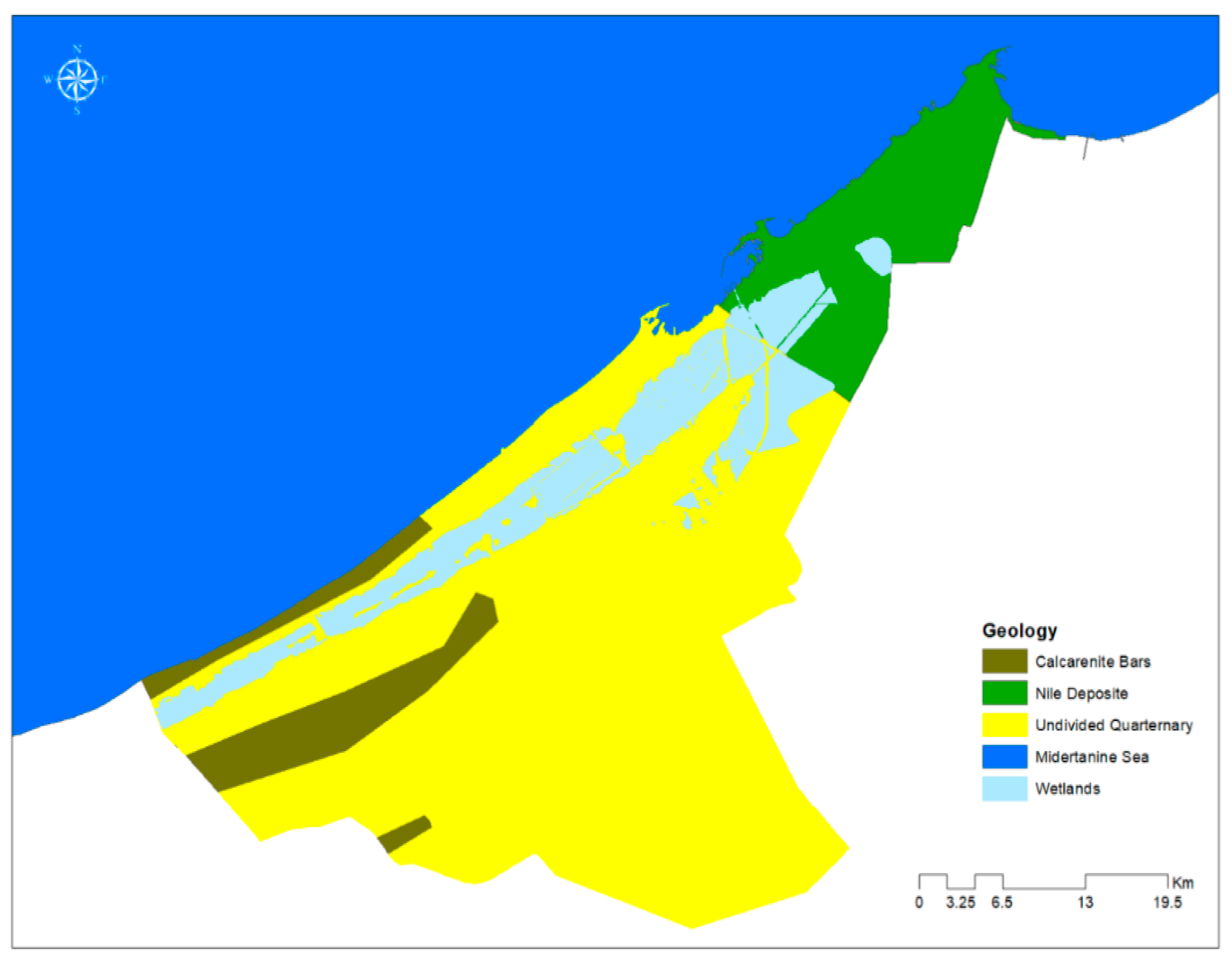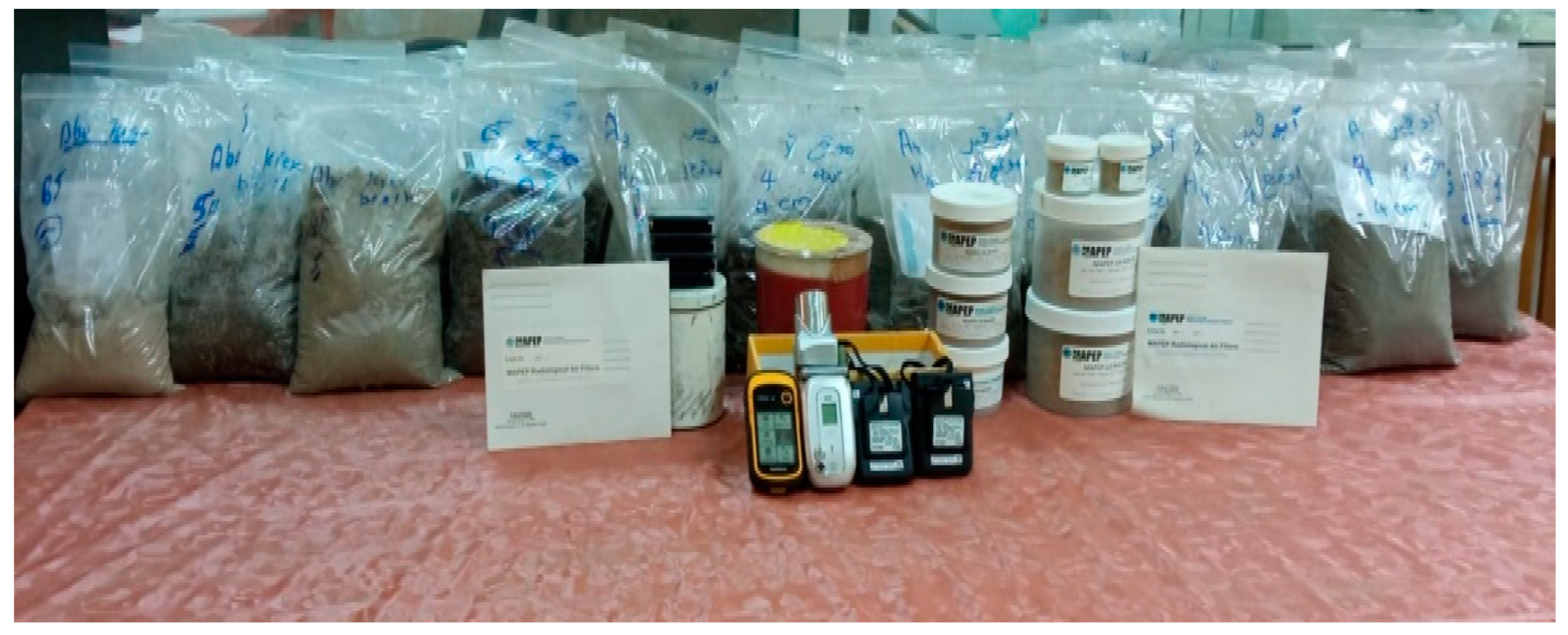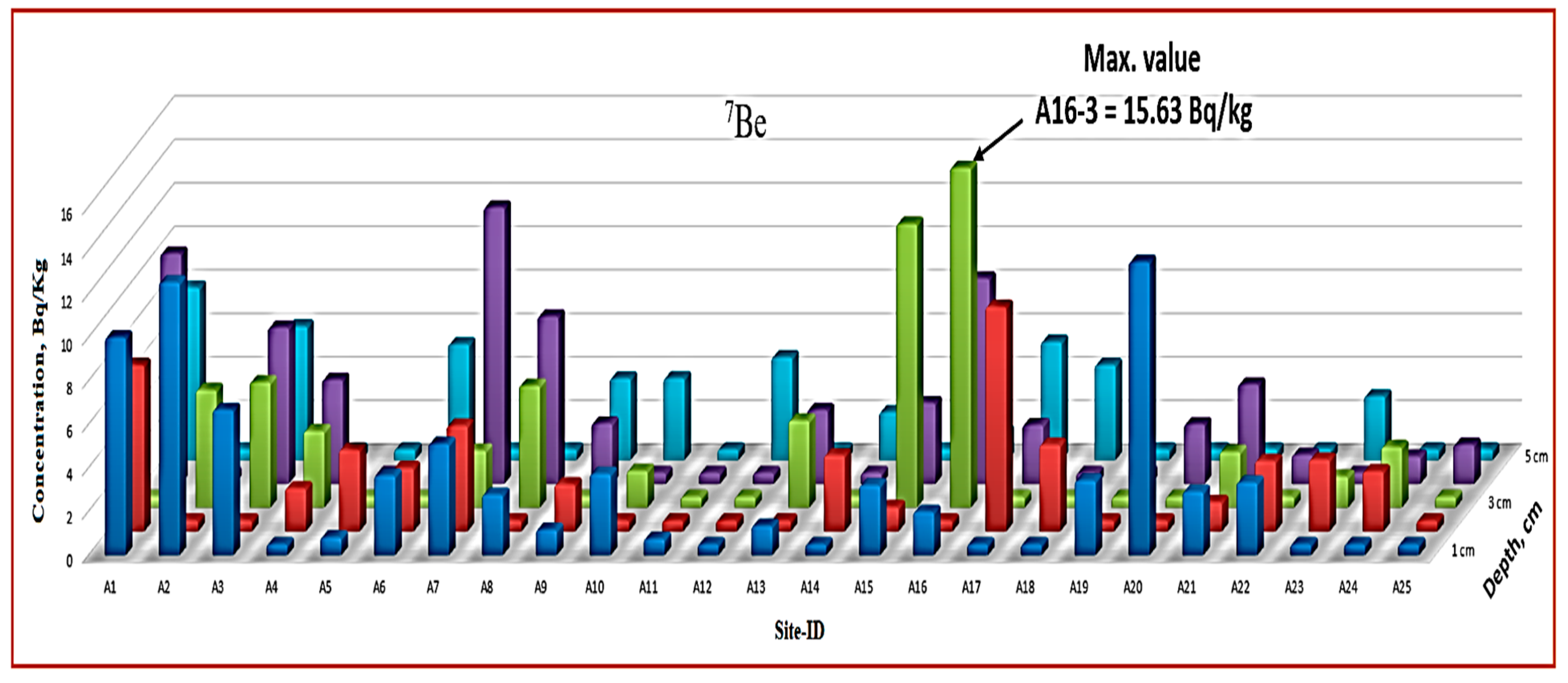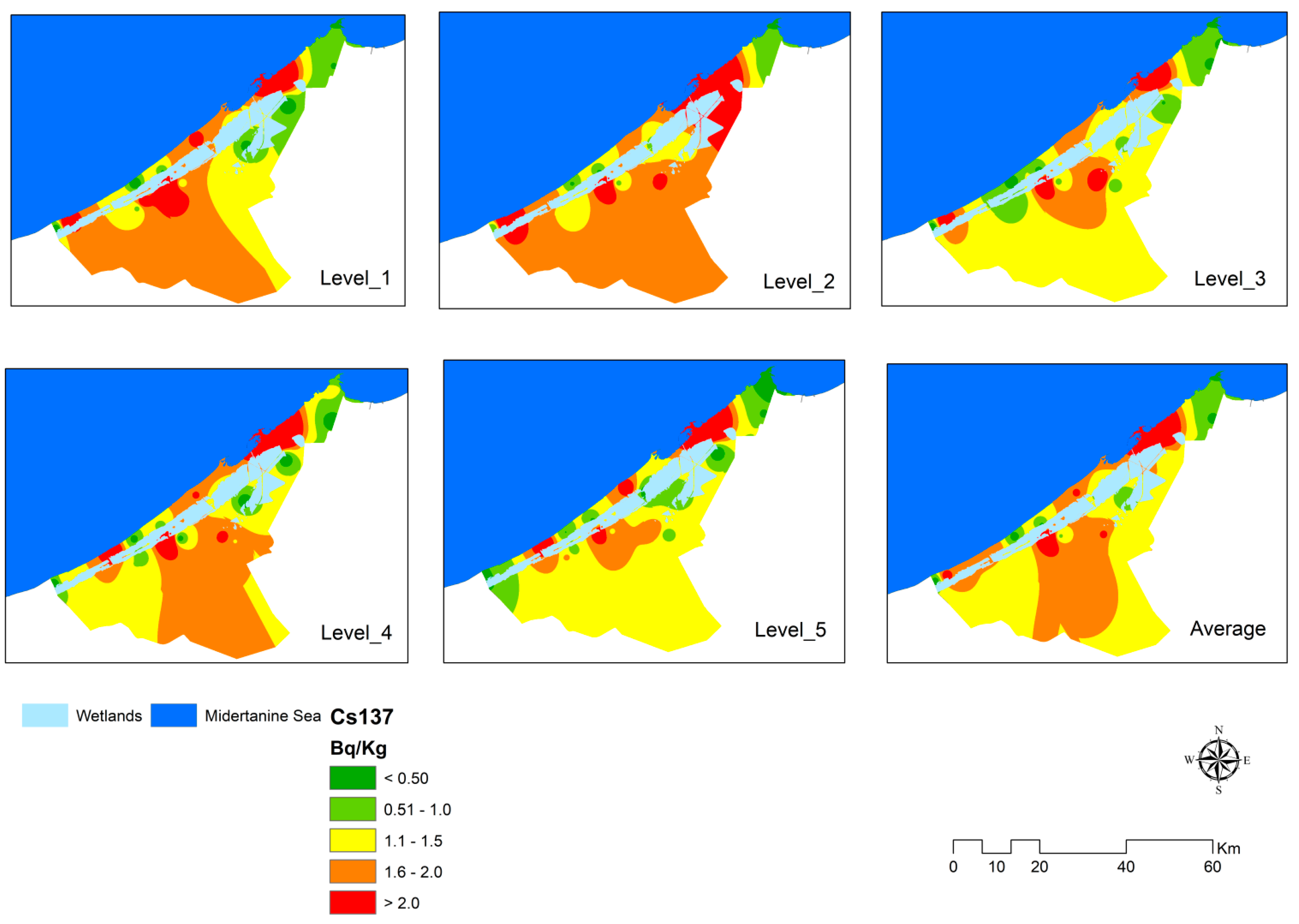Using 7Be and 137Cs for Assessing the Land Stability of Alexandria Region, Egypt
Abstract
1. Introduction
2. Materials and Methods
2.1. Study Area
2.2. Geology of the Area
2.3. Soil Sampling
2.4. Sample Collection and Preparation
2.5. Radioactivity Measurements
2.6. Soil Stability Indicator Calculations
2.6.1. Soil Erodibility and Residence Times
2.6.2. Soil Relaxation
3. Results and Discussion
3.1. Radionuclide Distribution
3.1.1. 7BeLevels in the Area
3.1.2. 137Cs Levels in the Area
3.2. Soil Stability Indicators
3.2.1. Surface Erosion Assessment, KS (y−1)
3.2.2. Average Erosion Assessment, KA (y−1)
3.2.3. Soil Subsidence h0 (cm)
4. Conclusions
- The results of the study on 7Be indicate that the distribution of its levels in the area is related to the soil stability in the short term. The evidence shows that about 73% of the area suffers from very low stability, 18% is classified as low stability, 4% as moderate, and only 5% is highly stable.
- The 137Cs levels are related to long-period stability, and their distribution shows that about 80% of the area has very low stability. Furthermore, 13% is low, 6% is moderate, and only 5% is characterized by high stability.
- The Borg El Arab area is the only area that is characterized by deposition of 7Be since the concentration of 7Be exceeds the concentration generated from its inventory.
- The highest subsidence was observed in (Zawia Abe Elkader/Elamria), recording a value of 83 cm.
- The lowest and highest values for surface erosion and average erosion were observed at the same sites: Sharq District and Elmontaza District, respectively.
- It is clear that eastern Alexandria is suffering from soil subsidence and is consequently more vulnerable.
- The obtained results can help in implementing soil conservation strategies where the study areas were found to suffer from the most instability.
- This study can help decision makers employ sustainable land use management and soil conservation measures to mitigate the consequences of climate change and implement proper adaptation.
- The developmental strategies at any selected site should be suitable for the geological hazards and geo-environmental conditions of the study area.
- Nuclear techniques can provide reliable results for assessing land stability and can be applied for studying other regions.
- The assessment of 137Cs and 7Be in highly heterogeneous environments, such as those found in the Mediterranean area, needs to be further investigated to improve the accuracy of the estimates of surface redistribution provided by environmental radionuclide fallout measurements.
Author Contributions
Funding
Institutional Review Board Statement
Informed Consent Statement
Data Availability Statement
Conflicts of Interest
References
- Koning, N.; Smaling, E. Environmental crisis or ‘lie of the land’? The debate on soil degradation in Africa. Land Use Policy 2005, 22, 3–11. [Google Scholar] [CrossRef]
- Abu Hammad, A.; Tumeizi, A. Land degradation: Socioeconomic and environmental causes and consequences in the eastern Mediterranean. Land Degrad. Dev. 2012, 23, 216–226. [Google Scholar] [CrossRef]
- Eswaran, H.; Lal, R.; Reich, P.F. Land degradation: An overview. In Response to Land Degradation; CRC Press: Boca Raton, FL, USA, 2019; pp. 20–35. [Google Scholar]
- Pimentel, D.; Harvey, C.; Resosudarmo, P.; Sinclair, K.; Kurz, D.; McNair, M.; Crist, S.; Shpritz, L.; Fitton, L.; Saffouri, R.; et al. Environmental and economic costs of soil erosion and conservation benefits. Science 1995, 267, 1117–1123. [Google Scholar] [CrossRef] [PubMed]
- Rosskopf, C.M.; Di Iorio, E.; Circelli, L.; Colombo, C.; Aucelli, P.P. Assessing spatial variability and erosion susceptibility of soils in hilly agricultural areas in Southern Italy. Int. Soil Water Conserv. Res. 2020, 8, 354–362. [Google Scholar] [CrossRef]
- Matisoff, G.; Whiting, P.J. Measuring soil erosion rates using natural (7Be, 210Pb) and anthropogenic (137Cs, 239,240Pu) radionuclides. In Handbook of Environmental Isotope Geochemistry; Springer: Berlin/Heidelberg, Germany, 2012; pp. 487–519. [Google Scholar]
- Mabit, L.; Benmansour, M.; Walling, D.E. Comparative advantages and limitations of the fallout radionuclides 137Cs, 210Pbex and 7Be for assessing soil erosion and sedimentation. J. Environ. Radioact. 2008, 99, 1799–1807. [Google Scholar] [CrossRef]
- Walling, D.E. Use of 137Cs and Other Fallout Radionuclide in Soil Erosion Investigations: Progress, Problems and Prospects; IAEA: Vienna, Austria, 1998. [Google Scholar]
- Santos, I.R.; Burnett, W.C.; Godoy, J.M. Radionuclides as tracers of coastal processes in Brazil: Review, synthesis, and perspectives. Braz. J. Oceanogr. 2008, 56, 115–130. [Google Scholar] [CrossRef]
- Sukadana, K.; Dercon, G.; Mabit, L.F.; Zapata, M.; Zaman, M.L.; Nguyen, L.K.H. Soil-Specific Farming: Precision Agriculture; CRC Press: Boca Raton, FL, USA, 2015; Volume 22, p. 247. [Google Scholar]
- Jasiulionis, R.; Wershofen, H. A study of the vertical diffusion of the cosmogenic radionuclides, 7Be and 22Na in the atmosphere. J. Environ. Radioact. 2005, 79, 157–169. [Google Scholar] [CrossRef] [PubMed]
- Blake, W.H.; Walling, D.E.; He, Q. Using cosmogenic beryllium-7 as a tracer in sediment budget investigations. Geogr. Ann. Ser. A—Phys. Geogr. 2002, 84A, 89–102. [Google Scholar] [CrossRef]
- Heikkilä, U.; Beer, J.; Abreu, J.A.; Steinhilber, F. On the atmospheric transport and deposition of the cosmogenic radionuclides (10Be): A review. Space Sci. Rev. 2013, 176, 321–332. [Google Scholar] [CrossRef]
- Steinmann, P.; Billen, T.; Loizeau, J.L.; Dominik, V. Beryllium-7 as a tracer to study mechanisms and rates of metal scavenging from lake surface waters. Geochim. Cosmochim. Acta 1999, 63, 1621–1633. [Google Scholar] [CrossRef]
- Blake, W.H.; Walling, D.E.; He, Q. Fallout beryllium-7 as a tracer in soil erosion investigations. Appl. Radiat. Isot. 1999, 51, 599–605. [Google Scholar] [CrossRef] [PubMed]
- Ryken, N.; Al-Barri, B.; Taylor, A.; Blake, W.; Maenhout, P.; Sleutel, S.; Tack, F.; Dierick, M.; Bodé, S.; Boeckx, P.; et al. Quantifying the spatial variation of 7Be depth distributions towards improved erosion rate estimations. Geoderma 2016, 269, 10–18. [Google Scholar] [CrossRef]
- Taylor, A.; Blake, W.H.; Smith, H.G.; Mabit, L.; Keith-Roach, M.J. Assumptions and challenges in the use of fallout beryllium-7 as a soil and sediment tracer in river basins. Earth-Sci. Rev. 2013, 126, 85–95. [Google Scholar] [CrossRef]
- Sigurgeirsson, M.Á.; Arnalds, O.; Pálsson, S.E.; Howard, B.J.; Gudnason, K. Radiocaesium fallout behaviour in volcanic soils in Iceland. J. Environ. Radioact. 2005, 79, 39–53. [Google Scholar] [CrossRef] [PubMed]
- Andrello, A.C.; Guimarães, M.D.F.; Appoloni, C.R.; Nascimento Filho, V.F.D. Use of cesium-137 methodology in the evaluation of superficial erosive processes. Braz. Arch. Biol. Technol. 2003, 46, 307–314. [Google Scholar] [CrossRef][Green Version]
- Abdrabo, M.A.; Abdelwahab, R.G.; Hassaan, M.A. Urban dynamics and potential vulnerability of coastal urban areas to sea level rise in the southeastern Levantine Basin. Urban Clim. 2022, 44, 101212. [Google Scholar] [CrossRef]
- Olsen, C.R.; Larsen, I.L.; Lowry, P.D.; Cutshall, N.H.; Nichols, M.M. Geochemistry and deposition of 7Be in river-estuarine and coastal waters. J. Geophys. Res. Ocean. 1986, 91, 896–908. [Google Scholar] [CrossRef]
- Saleh, I.H.; Abdel-Halim, A.A. 7Be in soil, deposited dust and atmospheric air and its using to infer soil erosion along Alexandria region, Egypt. J. Environ. Radioact. 2017, 172, 24–29. [Google Scholar] [CrossRef] [PubMed]
- Marestoni, L.D.; Martins, E.L.; Appoloni, C.R.; Andrello, A.C. 7Be Fallout for Superficial Soil Erosion Assessment; IAEA: Vienna, Austria, 2009. [Google Scholar]
- Isaksson, M.; Raaf, C.L. Environmental Radioactivity and Emergency Preparedness; CRC Press: Boca Raton, FL, USA, 2017. [Google Scholar]
- Taylor, A.; Blake, W.H.; Iurian, A.R.; Millward, G.E.; Mabit, L. The use of Be-7 as a soil and sediment tracer. In Assessing Recent Soil Erosion Rates through the Use of Beryllium-7 (Be-7); Springer: Cham, Switzerland, 2019; pp. 1–13. [Google Scholar]
- Mohamed, M.A.O. A Study on Radiological Baseline Assessment and Impacts of Nuclear Power Plant at El-Dabaa Region on Agriculture Soil of Alexandria-Egypt; Alexandria University: Alexandria, Egypt, 2018; Available online: https://maps.app.goo.gl/T3awoni3noQ4Bjzz6 (accessed on 20 January 2024).
- Jha, A.; Schkade, U.; Kirchner, G. Estimating short-term soil erosion rates after single and multiple rainfall events by modelling the vertical distribution of cosmogenic 7Be in soils. Geoderma 2015, 243, 149–156. [Google Scholar] [CrossRef]
- Schuller, P.; Iroumé, A.; Walling, D.E.; Mancilla, H.B.; Castillo, A.; Trumper, R.E. Use of beryllium-7 to document soil redistribution following forest harvest operations. J. Environ. Qual. 2006, 35, 1756–1763. [Google Scholar] [CrossRef] [PubMed]











| Site ID | Location Name | 7Be-Specific Activity (Bq/kg) | 137Cs-Specific Activity (Bq/kg) | ||||||||
|---|---|---|---|---|---|---|---|---|---|---|---|
| 1 cm | 2 cm | 3 cm | 4 cm | 5 cm | 1 cm | 2 cm | 3 cm | 4 cm | 5 cm | ||
| A1 | Bab Sharqui and Wabor Elmia | 10.01 ± 0.05 | 7.65 ± 0.05 | ≤0.50 | 10.59 ± 0.05 | 7.93 ± 0.05 | 5.08 ± 0.04 | 5.39 ± 0.04 | 3.63 ± 0.02 | 7.86 ± 0.05 | 6.47 ± 0.04 |
| A2 | Elagamy Elkeblia_Om Zigo | 12.54 ± 0.07 | ≤0.50 | 5.41 ± 0.04 | ≤0.50 | ≤0.50 | 1.49 ± 0.02 | 0.73 ± 0.01 | 1.22 ± 0.02 | 1.21 ± 0.02 | ≤0.11 |
| A3 | Sharq | 6.68 ± 0.03 | ≤0.50 | 5.77 ± 0.04 | 7.19 ± 0.04 | 6.15 ± 0.04 | 0.41 ± 0.01 | 1.13 ± 0.02 | 1.10 ± 0.02 | 0.84 ± 0.02 | 0.84 ± 0.02 |
| A4 | Sharq | ≤0.50 | 1.98 ± 0.01 | 3.52 ± 0.03 | 4.79 ± 0.04 | ≤0.50 | 0.83 ± 0.02 | 0.23 ± 0.00 | 0.63 ± 0.01 | 0.62 ± 0.01 | 1.52 ± 0.02 |
| A5 | Sharq | 0.82 ± 0.01 | 3.75 ± 0.04 | ≤0.50 | ≤0.50 | ≤0.50 | 0.18 ± 0.00 | 1.01 ± 0.02 | 0.41 ± 0.01 | 0.48 ± 0.01 | 0.97 ± 0.01 |
| A6 | Eltwfekia | 3.66 ± 0.03 | 2.91 ± 0.03 | ≤0.50 | ≤0.50 | 5.33 ± 0.04 | 0.48 ± 0.01 | 0.52 ± 0.01 | 0.44 ± 0.01 | ≤0.11 | 0.42 |
| A7 | Sharq | 5.12 ± 0.04 | 4.86 ± 0.04 | 2.63 ± 0.02 | 12.71 ± 0.06 | ≤0.50 | 0.72 ± 0.01 | 0.93 ± 0.02 | 0.43 ± 0.01 | 0.70 ± 0.01 | 0.23 ± 0.01 |
| A8 | Elmaamora | 2.78 ± 0.01 | ≤0.50 | 5.61 ± 0.04 | 7.70 ± 0.05 | ≤0.50 | 0.92 ± 0.01 | 0.73 ± 0.01 | 0.80 ± 0.01 | 1.26 ± 0.02 | 0.32 ± 0.01 |
| A9 | Abeis 7 | 1.17 ± 0.01 | 2.16 ± 0.02 | ≤0.50 | 2.78 ± 0.03 | 3.76 ± 0.03 | 0.13 ± 0.00 | 4.84 ± 0.04 | 0.49 ± 0.01 | ≤0.11 | ≤0.11 |
| A10 | Abokeer Elgariba | 3.74 ± 0.03 | ≤0.50 | 1.70 ± 0.01 | ≤0.50 | 3.77 ± 0.03 | ≤0.11 | ≤0.11 | 0.18 ± 0.00 | 0.56 ± 0.01 | 0.32 ± 0.01 |
| A11 | Abokeer Elgariba | 0.75 ± 0.01 | ≤0.50 | ≤0.50 | ≤0.50 | ≤0.50 | ≤0.11 | ≤0.11 | ≤0.11 | 0.45 ± 0.01 | 0.23 ± 0.01 |
| A12 | Elmontaza District | ≤0.50 | ≤0.50 | ≤0.50 | ≤0.50 | 4.73 ± 0.04 | ≤0.11 | 0.75 ± 0.01 | ≤0.11 | 0.32 ± 0.01 | 0.48 ± 0.01 |
| A13 | Elhawaria | 1.35 ± 0.01 | ≤0.50 | 4.01 ± 0.03 | 3.40 ± 0.03 | ≤0.50 | 5.41 ± 0.02 | 4.43 ± 0.04 | 4.37 ± 0.03 | 5.12 ± 0.04 | 2.99 ± 0.02 |
| A14 | Shyakha Baheg | ≤0.50 | 3.50 ± 0.03 | ≤0.50 | ≤0.50 | 2.21 ± 0.01 | 2.53 ± 0.03 | 1.36 ± 0.02 | 0.77 ± 0.01 | 0.71 ± 0.01 | 0.75 ± 0.01 |
| A15 | Shyakha Baheg | 3.21 ± 0.03 | 1.12 ± 0.01 | 13.05 ± 0.06 | 3.72 ± 0.03 | ≤0.50 | 0.87 ± 0.02 | 1.32 ± 0.01 | 0.84 ± 0.02 | 0.99 ± 0.02 | 1.57 ± 0.02 |
| A16 | Ketaa Elnahda | 1.99 ± 0.01 | ≤0.50 | 15.63 ± 0.08 | 9.44 ± 0.06 | 1.29 ± 0.01 | 1.18 ± 0.01 | 1.57 ± 0.02 | 0.56 ± 0.01 | 1.49 ± 0.02 | 0.80 ± 0.01 |
| A17 | Ketaa Maryout | ≤0.50 | 10.33 ± 0.06 | ≤0.50 | 2.71 ± 0.02 | 5.44 ± 0.04 | 1.13 ± 0.02 | 2.28 ± 0.03 | 2.96 ± 0.03 | 2.19 ± 0.01 | 1.99 ± 0.03 |
| A18 | Zawia Abe Elkader | ≤0.50 | 3.98 ± 0.04 | ≤0.50 | ≤0.50 | 4.38 ± 0.04 | 0.38 ± 0.01 | 1.08 ± 0.02 | 0.86 ± 0.01 | 0.27 ± 0.01 | 0.64 ± 0.01 |
| A19 | Elzraa Elbahary | 3.43 ± 0.03 | ≤0.50 | ≤0.50 | 0.53 ± 0.01 | ≤0.50 | 2.17 ± 0.03 | 1.71 ± 0.02 | 1.97 ± 0.02 | 2.05 ± 0.01 | 2.42 ± 0.03 |
| A20 | Borg Elarab | 13.48 ± 0.06 | ≤0.50 | ≤0.50 | 2.75 ± 0.03 | ≤0.50 | ≤0.11 | 0.46 ± 0.01 | 0.21 ± 0.00 | 0.36 ± 0.01 | 0.50 ± 0.01 |
| A21 | Elsahal Elshamaly | 2.92 ± 0.03 | 1.35 ± 0.01 | 2.57 ± 0.03 | 4.58 ± 0.04 | ≤0.50 | 1.37 ± 0.02 | 1.68 ± 0.01 | 0.94 ± 0.02 | 2.94 ± 0.03 | 2.79 ± 0.01 |
| A22 | Hod Sokara We Abo-Hamad | 3.34 ± 0.03 | 3.24 ± 0.03 | ≤0.50 | 1.33 ± 0.01 | ≤0.50 | 2.86 ± 0.03 | 3.45 ± 0.03 | 2.81 ± 0.03 | 1.45 ± 0.01 | 0.78 ± 0.02 |
| A23 | Hod Sokara We Abo-Hamad | ≤0.50 | 3.30 ± 0.03 | 1.43 ± 0.01 | ≤0.50 | 2.94 ± 0.03 | 0.26 ± 0.01 | 0.65 ± 0.01 | 0.27 ± 0.01 | 0.33 ± 0.01 | 0.17 ± 0.01 |
| A24 | Elhawaria | ≤0.50 | 2.76 ± 0.03 | 2.79 ± 0.03 | 1.25 ± 0.02 | ≤0.50 | 0.41 ± 0.01 | 0.39 ± 0.01 | 0.26 ± 0.01 | 0.56 ± 0.01 | 0.41 ± 0.01 |
| A25 | Elhawaria | ≤0.50 | ≤0.50 | ≤0.50 | 1.81 ± 0.01 | ≤0.50 | 1.19 ± 0.02 | 0.85 ± 0.02 | 0.80 ± 0.02 | 0.29 ± 0.01 | 1.46 ± 0.02 |
| Range of 7Be in Bq/kg | Stability Class | Area Percentage % |
|---|---|---|
| 0–3.9 | Very low | 73% |
| 4–7.9 | Low | 18% |
| 8–11.9 | Moderate | 4% |
| 12–16 | High | 5% |
| Range of 137Cs in Bq/kg | Stability Class | Area Percentage % |
|---|---|---|
| 0–1.9 | Very low | 80% |
| 2–3.9 | Low | 12.8% |
| 4–5.9 | Moderate | 5.6% |
| 6–8 | High | 1.6% |
| Erosion Class (y−1) | Erosion | Stability | Area (km2) | % |
|---|---|---|---|---|
| <0 | Accretion (-) | Deposition (Buildup) | 2.24 | 0.13 |
| 0–5 | Very Low | Very High | 83.50 | 4.97 |
| 5–10 | Low | High | 662.84 | 39.47 |
| 10–15 | Moderate | Moderate | 747.96 | 44.54 |
| 15–20 | High | Low | 121.45 | 7.23 |
| >20 | Very High | Very Low | 61.49 | 3.66 |
| Erosion Class (y−1) | Erosion | Stability | Area (km2) | % |
|---|---|---|---|---|
| <45 | Very Low | Very High | 127.22 | 7.58 |
| 45–50 | Low | High | 299.60 | 17.84 |
| 50–55 | Moderate | Moderate | 192.91 | 11.49 |
| 55–60 | High | Low | 346.25 | 20.62 |
| >65 | Very High | Very Low | 712.14 | 42.48 |
| Subsidence Class (cm) | Relaxation | Stability | Area (km2) | % |
|---|---|---|---|---|
| <3 | Very Low | Very High | 95.80 | 5.70 |
| 3–6 | Low | High | 458.63 | 27.31 |
| 6–9 | Moderate | Moderate | 495.37 | 29.50 |
| 9–15 | High | Low | 358.61 | 21.35 |
| >15 | Very high | Very Low | 271.04 | 16.14 |
| h (cm) | Reference | City/Country |
|---|---|---|
| 0.6–83 | Present study | Alexandria/Egypt |
| 0.87–1.26 | [26] | Alexandria/Egypt (Agricultural Soil) |
| 1.35–6.80 | [14] | Alexandria/Egypt |
| 1.60 | [27] | Germany |
| 4.17 | [23] | Brazil |
| 2.14 | [28] | Chile |
| 5.40 | [15] | UK |
Disclaimer/Publisher’s Note: The statements, opinions and data contained in all publications are solely those of the individual author(s) and contributor(s) and not of MDPI and/or the editor(s). MDPI and/or the editor(s) disclaim responsibility for any injury to people or property resulting from any ideas, methods, instructions or products referred to in the content. |
© 2024 by the authors. Licensee MDPI, Basel, Switzerland. This article is an open access article distributed under the terms and conditions of the Creative Commons Attribution (CC BY) license (https://creativecommons.org/licenses/by/4.0/).
Share and Cite
Saleh, I.H.; Ibrahim, N.M.; Hassaan, M.A.; Ghatass, Z.F.; Arayro, J.; Mezher, R.; Ibosayyed, M.; Elsafi, M. Using 7Be and 137Cs for Assessing the Land Stability of Alexandria Region, Egypt. Sustainability 2024, 16, 1692. https://doi.org/10.3390/su16041692
Saleh IH, Ibrahim NM, Hassaan MA, Ghatass ZF, Arayro J, Mezher R, Ibosayyed M, Elsafi M. Using 7Be and 137Cs for Assessing the Land Stability of Alexandria Region, Egypt. Sustainability. 2024; 16(4):1692. https://doi.org/10.3390/su16041692
Chicago/Turabian StyleSaleh, Ibrahim H., Nessma M. Ibrahim, Mahmoud Adel Hassaan, Zekry F. Ghatass, Jack Arayro, Rabih Mezher, Mohmad Ibosayyed, and Mohamed Elsafi. 2024. "Using 7Be and 137Cs for Assessing the Land Stability of Alexandria Region, Egypt" Sustainability 16, no. 4: 1692. https://doi.org/10.3390/su16041692
APA StyleSaleh, I. H., Ibrahim, N. M., Hassaan, M. A., Ghatass, Z. F., Arayro, J., Mezher, R., Ibosayyed, M., & Elsafi, M. (2024). Using 7Be and 137Cs for Assessing the Land Stability of Alexandria Region, Egypt. Sustainability, 16(4), 1692. https://doi.org/10.3390/su16041692









